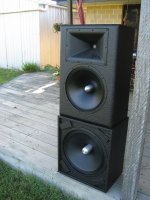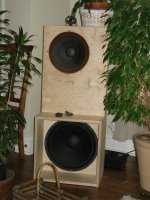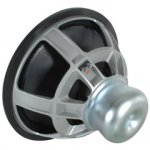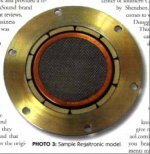I was looking for a driver that can replace the JBL 2235H, and the AE Speakers Lambada Series TD15H has come up for prime consideration.
However, it has been suggested that there could be a mechanical resonance at 1.6 KHz due to the particular surround used. I am looking at the Reflexion Arts 234 speaker which uses an asymmetrical crossover - LPF is 12 dB @ 1000 Hz, HPF is 24 dB @ 1000 Hz.
How problematic is the 1.6 KHz resonance likely to be when the speaker is crossed over 12 dB @ 1000 Hz?
However, it has been suggested that there could be a mechanical resonance at 1.6 KHz due to the particular surround used. I am looking at the Reflexion Arts 234 speaker which uses an asymmetrical crossover - LPF is 12 dB @ 1000 Hz, HPF is 24 dB @ 1000 Hz.
How problematic is the 1.6 KHz resonance likely to be when the speaker is crossed over 12 dB @ 1000 Hz?
I was looking for a driver that can replace the JBL 2235H, and the AE Speakers Lambada Series TD15H has come up for prime consideration.
However, it has been suggested that there could be a mechanical resonance at 1.6 KHz due to the particular surround used. I am looking at the Reflexion Arts 234 speaker which uses an asymmetrical crossover - LPF is 12 dB @ 1000 Hz, HPF is 24 dB @ 1000 Hz.
How problematic is the 1.6 KHz resonance likely to be when the speaker is crossed over 12 dB @ 1000 Hz?
I have 2235Hs that I replaced with TD15H in July. My crossover point is about 500 Hz. I have no issues with resonance. I can't say what it would sound like at 1 kHz.
I love JBL, but the AE TD15Hs are clearly superior drivers. I would not hesitate to do it all over again. I should sell my old 2235Hs since they are just sitting in cardboard boxes.
I have 2235Hs that I replaced with TD15H in July. My crossover point is about 500 Hz.
What have you paired it with?
What have you paired it with?
Audax PR170M for the mid and Morel MDT38 for the high end.
Crossovers are passive at 500 Hz and 2.5 kHz.
Audax PR170M for the mid and Morel MDT38 for the high end.
Crossovers are passive at 500 Hz and 2.5 kHz.
Thank you for your quick response. For myself, I am looking at a two way system.
Thank you for your quick response. For myself, I am looking at a two way system.
Yeah, looked at that idea long and hard a while back with no good alternatives that I liked then. The TD15H has a very high crossover point potential for a large woofer, so I was interested in seeing if I could do that.
The best way I could see doing a 15" 2-way was with a horn, but that is tricky to do and get good performance. The next choice was mating a full-range to the woofer, but that is a bit of a compromise, too.
What have you in mind to use?
I own and use the 15X and 2225/6 and agree with what the others are saying. I would either go three way in a WMT with the 15H or use the 15M if I were intent on using it like the RA234 speaker. Here the wide C-C spacing of the 15's especially if used that high could be problematic.
Last edited:
I like the sound of the Lambda TD15S woofer and have built about twenty speakers with them. The TD15S with Qts ~ 0.37 and Fs ~ 22 Hz provides -3db at 25Hz in a 10 cu ft ported box before room gain. I think the low Qts TD15H is optimized for horn loading if you need under 40Hz with high efficiency.
If you want a high 1KHz xover plus high efficiency, the Lambda TD18H+ can be used with the Lambda TD15LO and a 1Khz controlled directivity 1" horn/waveguide. The TD15LO uses an under hung motor with the TD15M pleated edge cone.
I only design 3-way speakers and appreciate the upper midbass quality of the Lambda 15" woofers, but I seldom use bass crossovers over 160Hz. Hence, I have been watching for how new underhung NdFeB motor technology and carbon fiber loaded paper cone technology can deliver a high sound quality 18" woofer, but I have yet to find a genius solution for home audio. (90-100 gram Mms, underhung motor, 20Hz Fs, 0.37 Qts, 97 db/watt SPL, 200 watt compromise). An 18" with Qts ~0.8 also seems like the ideal choice for dipoles. With technology advancements, 18" is the new 15", and NdFeB is the new AlNiCo for bass.
If you want a high 1KHz xover plus high efficiency, the Lambda TD18H+ can be used with the Lambda TD15LO and a 1Khz controlled directivity 1" horn/waveguide. The TD15LO uses an under hung motor with the TD15M pleated edge cone.
I only design 3-way speakers and appreciate the upper midbass quality of the Lambda 15" woofers, but I seldom use bass crossovers over 160Hz. Hence, I have been watching for how new underhung NdFeB motor technology and carbon fiber loaded paper cone technology can deliver a high sound quality 18" woofer, but I have yet to find a genius solution for home audio. (90-100 gram Mms, underhung motor, 20Hz Fs, 0.37 Qts, 97 db/watt SPL, 200 watt compromise). An 18" with Qts ~0.8 also seems like the ideal choice for dipoles. With technology advancements, 18" is the new 15", and NdFeB is the new AlNiCo for bass.
Attachments
Yeah, looked at that idea long and hard a while back with no good alternatives that I liked then. The TD15H has a very high crossover point potential for a large woofer, so I was interested in seeing if I could do that.
The best way I could see doing a 15" 2-way was with a horn, but that is tricky to do and get good performance. The next choice was mating a full-range to the woofer, but that is a bit of a compromise, too.
What have you in mind to use?
I am looking for a suitable compression driver similar to the TAD2001 and I have found several links to pursue. 15" woofers that can handle ultra lows and be crossed over above 1000 Hz are harder to find.
I like the sound of the Lambda TD15S woofer and have built about twenty speakers with them. The TD15S with Qts ~ 0.37 and Fs ~ 22 Hz provides -3db at 25Hz in a 10 cu ft ported box before room gain. I think the low Qts TD15H is optimized for horn loading if you need under 40Hz with high efficiency.
Thank you very much. Exactly the kind of advice I am looking for. Hope John E Janowitz will chime in for some additional clarity. He compared the TD15"H" and the JBL 2235H here and they were almost identical in the LF region.
If you want a high 1KHz xover plus high efficiency, the Lambda TD18H+ can be used with the Lambda TD15LO and a 1Khz controlled directivity 1" horn/waveguide. The TD15LO uses an under hung motor with the TD15M pleated edge cone.
Somehow, I am currently set on two way speakers, but this may change by the time I build my pair.
I only design 3-way speakers and appreciate the upper midbass quality of the Lambda 15" woofers, but I seldom use bass crossovers over 160Hz. Hence, I have been watching for how new underhung NdFeB motor technology and carbon fiber loaded paper cone technology can deliver a high sound quality 18" woofer, but I have yet to find a genius solution for home audio. (90-100 gram Mms, underhung motor, 20Hz Fs, 0.37 Qts, 97 db/watt SPL, 200 watt compromise). An 18" with Qts ~0.8 also seems like the ideal choice for dipoles. With technology advancements, 18" is the new 15", and NdFeB is the new AlNiCo for bass.
It is refreshing to see somebody who is actually looking forward to new technology.
 I am meeting too many people who believe that the best days of hi-fi are behind us.
I am meeting too many people who believe that the best days of hi-fi are behind us. 
Last edited:
Hence, I have been watching for how new underhung NdFeB motor technology and carbon fiber loaded paper cone technology can deliver a high sound quality 18" woofer, but I have yet to find a genius solution for home audio. (90-100 gram Mms, underhung motor, 20Hz Fs, 0.37 Qts, 97 db/watt SPL, 200 watt compromise). 18" is the new 15", and NdFeB is the new AlNiCo for bass.
LineSource
Have you actually found an 18" bass driver with NdFeB? I saw that you had the SS Illuminator but I don't think they make an 18
Lots of pro driver manufacturers make them.LineSource
Have you actually found an 18" bass driver with NdFeB? I saw that you had the SS Illuminator but I don't think they make an 18
Lots of pro driver manufacturers make them.
Can you be specific about which ones are using underhung NdFeB motors and carbon fibre loaded paper cones? thanks
LineSource
Have you actually found an 18" bass driver with NdFeB? )
I have not yet found the perfect home 18" woofer. I am sure that an ideal 18" home audio bass speaker is possible to build from current technology. The main compromise required is a 200 watt maximum power dissipation from a 2.5-3" diameter short underhung voice coil to allow low Mms and high BW from short underhung, low Le coil designs.
Almost all 18" woofers are optimized for pro audio with a ~40Hz F3 goal and safe 500-1000 watt power dissipation from very heavy voice coils. There are several companies that have excellent low inductance underhung NdFeB motors(Aura picture). There are several companies that have carbon fiber loaded 18" cones that are stiff, light, and resistant to resonance. A radial cabon fiber skeleton is as good as a slit cone for reducing resonance. If you play with a speaker T/S parameter spreadsheet with a 200 watt copper clad Al voice coil, it is easy to spec ideal home audio 18" ported and dipole woofers.
The advance of technology makes 18" woofers the ideal size for home audio bass(xover under 300Hz). Stacking two 15" woofers on top of eachother for efficiency like old school JBL is just too high for optimal seated HT listening.
Attachments
Well, pro drivers are almost always overhung. As for the material of the diaphragm, I don't see why you'd be hung up about that.Can you be specific about which ones are using underhung NdFeB motors and carbon fibre loaded paper cones? thanks
I like the sound of the Lambda TD15S woofer and have built about twenty speakers with them. The TD15S with Qts ~ 0.37 and Fs ~ 22 Hz provides -3db at 25Hz in a 10 cu ft ported box before room gain. I think the low Qts TD15H is optimized for horn loading if you need under 40Hz with high efficiency.
If you want a high 1KHz xover plus high efficiency, the Lambda TD18H+ can be used with the Lambda TD15LO and a 1Khz controlled directivity 1" horn/waveguide. The TD15LO uses an under hung motor with the TD15M pleated edge cone.
I only design 3-way speakers and appreciate the upper midbass quality of the Lambda 15" woofers, but I seldom use bass crossovers over 160Hz. Hence, I have been watching for how new underhung NdFeB motor technology and carbon fiber loaded paper cone technology can deliver a high sound quality 18" woofer, but I have yet to find a genius solution for home audio. (90-100 gram Mms, underhung motor, 20Hz Fs, 0.37 Qts, 97 db/watt SPL, 200 watt compromise). An 18" with Qts ~0.8 also seems like the ideal choice for dipoles. With technology advancements, 18" is the new 15", and NdFeB is the new AlNiCo for bass.
Pr any with the apogee yet ?
I have not yet found the perfect home 18" woofer. I am sure that an ideal 18" home audio bass speaker is possible to build from current technology. The main compromise required is a 200 watt maximum power dissipation from a 2.5-3" diameter short underhung voice coil to allow low Mms and high BW from short underhung, low Le coil designs.
Almost all 18" woofers are optimized for pro audio with a ~40Hz F3 goal and safe 500-1000 watt power dissipation from very heavy voice coils.
Thanks for your reply. I'm running two 15s a side up to 300Hz so one 18 is a good option. Baffle width wouldn't be much different either. Hope someone comes up with one
BTW I was thinking the Lambda dipole has a few of the necessary characteristics obviously without the neo magnet and the necessary diameter
Well, pro drivers are almost always overhung. As for the material of the diaphragm, I don't see why you'd be hung up about that.
I'm interested in the cone material, the magnet, the motor, the whole lot. I already use prodrivers so I was hoping you could add something to the discussion.
In regards to the original post, the TD15H "can" play to 1600hz. The response of the TD15H and TD15X are mostly the same other than the low end since they use all the same parts, only a different VC. This changes the Q and affects the low end response but has little change in the upper end. You can see augerpro's measurements of the TD15X here:
Frequency Response - drivervault
Impedance is also very flat and extends to nearly 10KHz before the resistance doubles from it's nominal value. The unchanging Le with respect to excursion also is a huge benefit. Without this constant Le, the upper end of the response curve varies with excursion throwing off any crossover, specifically in a passive system, but also in an active.
Impedance - drivervault
That all said, look at the off axis response by 1600hz. As with any 15" driver the response will be varying as you get farther off axis by that frequency. This really determines the upper end limit more than anything else. At 20 degrees off axis the response at 1600hz is only down about 3dB but by 40dB it is around 10dB down. At 1KHz though it is much less. Only about 1dB down by 20 degrees off axis and only about 3dB down by 40degrees. This is much more manageable and a more realistic upper end limit.
For a 2way, there are several options to go with in waveguides/horns that will allow you to mate to the TD15. My favorite option to date is not actually a 2way as it uses a coaxial compression driver. However that portion can be done passively. The 18sound XT1464 with the BMS 4594ND is very difficult to beat. This compression driver fits on the horn and has a 1.4" throat and the large diaphragm covers up to 7KHz range where the smaller diaphragm takes over from there. I have yet to find a compression driver that can offer better performance.
Overview
The only change I would make would be to go with the TD15M instead of the TD15H if you do not already have the H. The extra efficiency and extended response are beneficial in a system of this type.
Regarding Neo, the only benefit with going to Neo over ceramic is weight. In a pro system with many drivers, this can be more critical. For a home system where it won't be moved on a regular basis it has no real benefit. With a neo motor we could get a TD15 from about 27lbs down to around 18-20lbs. A radial neo has the benefit of much lower flux modulation as the strong force of the magnet is right next to the VC. The same went for the old Alnico magnets that were placed in the pole right next to the VC. The full copper sleeve on the pole is just as effective at reducing flux modulation but has the additional benefit of linearizing inductance with respect to excursion.
The only further way to get more linearity is to linearize BL, which is what an underhung motor will do. Our Dipole series all take advantage of the underhung as we want a higher Q but more linearity as the dipole drivers require more excursion to compensate for the baffle losses.
John
Frequency Response - drivervault
Impedance is also very flat and extends to nearly 10KHz before the resistance doubles from it's nominal value. The unchanging Le with respect to excursion also is a huge benefit. Without this constant Le, the upper end of the response curve varies with excursion throwing off any crossover, specifically in a passive system, but also in an active.
Impedance - drivervault
That all said, look at the off axis response by 1600hz. As with any 15" driver the response will be varying as you get farther off axis by that frequency. This really determines the upper end limit more than anything else. At 20 degrees off axis the response at 1600hz is only down about 3dB but by 40dB it is around 10dB down. At 1KHz though it is much less. Only about 1dB down by 20 degrees off axis and only about 3dB down by 40degrees. This is much more manageable and a more realistic upper end limit.
For a 2way, there are several options to go with in waveguides/horns that will allow you to mate to the TD15. My favorite option to date is not actually a 2way as it uses a coaxial compression driver. However that portion can be done passively. The 18sound XT1464 with the BMS 4594ND is very difficult to beat. This compression driver fits on the horn and has a 1.4" throat and the large diaphragm covers up to 7KHz range where the smaller diaphragm takes over from there. I have yet to find a compression driver that can offer better performance.
Overview
The only change I would make would be to go with the TD15M instead of the TD15H if you do not already have the H. The extra efficiency and extended response are beneficial in a system of this type.
Regarding Neo, the only benefit with going to Neo over ceramic is weight. In a pro system with many drivers, this can be more critical. For a home system where it won't be moved on a regular basis it has no real benefit. With a neo motor we could get a TD15 from about 27lbs down to around 18-20lbs. A radial neo has the benefit of much lower flux modulation as the strong force of the magnet is right next to the VC. The same went for the old Alnico magnets that were placed in the pole right next to the VC. The full copper sleeve on the pole is just as effective at reducing flux modulation but has the additional benefit of linearizing inductance with respect to excursion.
The only further way to get more linearity is to linearize BL, which is what an underhung motor will do. Our Dipole series all take advantage of the underhung as we want a higher Q but more linearity as the dipole drivers require more excursion to compensate for the baffle losses.
John
- Status
- This old topic is closed. If you want to reopen this topic, contact a moderator using the "Report Post" button.
- Home
- Loudspeakers
- Multi-Way
- Lambda Series TD15H



